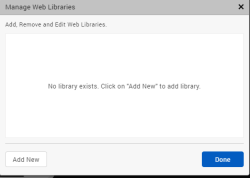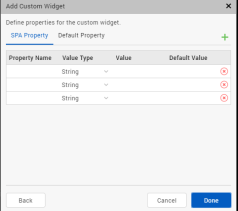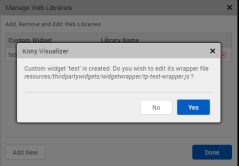Custom Widgets for Desktop Web
A custom widget is a group of widgets created to perform a specific task, functionality or signal.
In Quantum Visualizer, you can use custom widgets in the following methods.
- Custom widgets created using third party web libraries and frameworks.
- Custom widgets created in Quantum Visualizer and wrapped as components. These components can be re-used in other applications. For more information about how to create components and use them, refer the Working with Components.
This document describes the process of using custom widgets using third party web libraries and frameworks in the Desktop web channel and how to import them as a component.
This section provides information about the following processes of custom widgets in Desktop web applications.
- Defining new custom widgets in Quantum Visualizer
- Edit Custom Widget and Wrapper in Quantum Visualizer
- Clip Bounds Property for Custom widget
- Import the Custom Widget into Quantum Visualizer
- Export a Custom Widget in Quantum Visualizer
- Delete a Custom Widget in Quantum Visualizer
Defining New Custom Widgets in Quantum Visualizer
You can define custom widgets in Quantum Visualizer using a third party library or framework.
Here are the steps for defining a third-party custom widgets or web library in a Desktop Web application using Quantum Visualizer.
- In Quantum Visualizer, open the application to which you want to add the custom web widget.
- From the Edit menu of the Visualizer, select Manage Web Libraries.
The Manage Web Libraries window appears.
- To add a new custom widget, click Add New.
The Add Custom Widget window appears. - In the Add Custom Widget window, provide the following information:
- Widget Name: The name used to display the custom widget in your application.
- Widget Library: Click Browse to navigate to the location of the folder containing the custom widget/ library.
NOTE: To reuse a third-party library already added to your application, select the required library from the Widget Library drop-down list.
- Export as Component: Toggle the switch to On to add the custom widget as a component to your application.

When you Toggle the switch to Off, the custom widget is not added as a component.
The custom widget is added as a new widget to the Default Library of Quantum Visualizer.
- Click Next.
- In the new window that appears customize the properties of the custom widget as per your requirement, and then click Done.

The Create New Component with Contract window appears. - Provide the following details in the Create New Component with Contract window:
- Namespace: Provide the name of the namespace of the component
- Name: Provide the name of the component that will contain the custom widget.
This field is auto-populated with the name of the custom widget.
- Click OK.
- The custom widget is added to your application with a default wrapper contract file.
Click Yes, to edit the custom widget wrapper.js file.
Click No, if not required.
For more information about how to write and import a contract definition file, refer Write and Import the Contract Definition File. - Click Done.
The new custom widget has been added to the Templates explorer, under Components.
The custom widget is also be added under Default Library on the bottom-left of your canvas.
Write and Import the Contract Definition File
When you create or import a custom widget into Quantum Visualizer, two functions are created automatically inside the widget wrapper file: initializeWidget and modelChange.
When the initializeWidget function is created, it does not contain any code. However, the initializeWidget function might contain the code for library initialization as a comment. You must edit this function to provide the code for making the custom widget functional. This code has the configurations required for the custom widget to start working including the initialization of the objects.
All changes in state are notified to the custom widget through the widget wrapper contract (modelChange). The developer of the custom widget and its wrapper can make use of the information provided in the modelChange call and make changes to the custom widget state accordingly.
Edit Custom Widget and Wrapper in Quantum Visualizer
After adding the Custom widgets, you can edit the custom widget and wrapper.js file in Quantum Visualizer.
You can edit all the properties of the custom widget except for the name of the custom widget.
Follow these steps to edit the custom widget and widget wrapper.js file.
- From the Edit menu of the Visualizer, select Manage Web Libraries.
- In the Manage Web Libraries window, select the
 icon to edit the custom widget.
icon to edit the custom widget.
The Edit Custom Widget window appears. - Click Next.
- In the new window, customize the properties of the custom widget as required.
- In the same window, under Files, for the custom widget wrapper, select
 icon to edit the wrapper.js file.
icon to edit the wrapper.js file.
The custom widget wrapper file opens in the JS code editor
Clip Bounds Property for Custom widget
From Quantum Visualizer V9 SP2 FP7 , support for the Clip Bounds property is available for custom widgets in a Responsive Web app. Using this feature, developers can enable or disable the visibility of the content overflow. Content overflow is the content that appears outside the view area of the widget. The default value for the Clip Bounds property is OFF. When the Clip Bounds property is set to OFF, the content overflow is visible. Prior to the V9 SP2 FP7 release, to display the content overflow, developers had to modify the custom widget dimensions, which creates layout issues in some cases.
NOTE: For existing custom widgets, the default value of the Clip Bounds property is ON. For new custom widgets, the default value of the clip Bounds property is OFF.
For example, if the HTML content that is rendered by a third-party library exceeds the custom widget dimensions, content overflow occurs. Using the Clip Bounds property, developers can configure whether the content must be clipped or must be allowed to overflow.
Import the Custom Widget into Quantum Visualizer
Follow these steps to import a custom web widget into your applications.
- Using Quantum Visualizer open the web application to which you want to add the custom widget.
- From the Project menu of the Visualizer, navigate to Import > Custom Web Widget.
A file explorer window appears. - Navigate to the folder containing the zip file of the custom widget. Select the custom widget.
- Click Open.
The custom widget has been successfully imported to your application.
Export a Custom Widget in Quantum Visualizer
Follow these steps to export the custom widget and widgetwrapper.js file.
- From the Edit menu of the Visualizer, select Manage Web Libraries.
- In the Manage Web Libraries window, select the
 icon to export the custom widget.
icon to export the custom widget.
A file explorer window appears. - Select a folder from your system.
Click Select Folder.
The custom widget is now saved as a zip file in the specified folder.
Delete a Custom Widget in Quantum Visualizer
Follow these steps to delete the custom widget from your applicaation.
- From the Edit menu of the Visualizer, select Manage Web Libraries.
- In the Manage Web Libraries window, select the
 icon to delete the custom widget.
icon to delete the custom widget.
A Visualizer dialog appears. - Click Yes.
The custom widget is now deleted from your application.
